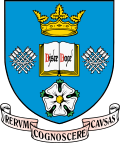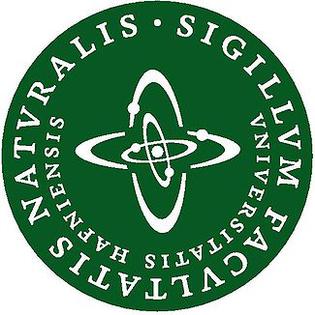
The Faculty of Science at the University of Copenhagen houses 12 departments, including the Natural History Museum of Denmark. The faculty also encompasses several national and international research centres, and has a number of field stations in Denmark and Greenland, among them the university's Arctic Station in central West Greenland. The faculty's administration is housed at the university's Frederiksberg Campus.

The Texas A&M University College of Science was an academic science college of Texas A&M University in College Station. It was founded in 1924. The faculty included a Nobel laureate and three National Academy of Sciences members. The college was dissolved in 2022, two years before what would have been its 100th year in existence.
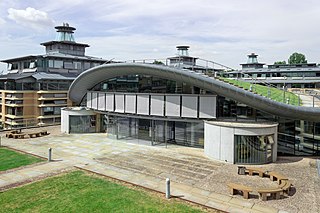
The Faculty of Mathematics at the University of Cambridge comprises the Department of Pure Mathematics and Mathematical Statistics (DPMMS) and the Department of Applied Mathematics and Theoretical Physics (DAMTP). It is housed in the Centre for Mathematical Sciences site in West Cambridge, alongside the Isaac Newton Institute. Many distinguished mathematicians have been members of the faculty.

Fargate is a pedestrian precinct and shopping area in Sheffield, England. It runs between Barker's Pool and High Street opposite the cathedral. It was pedestrianised in 1973. Fargate also holds a Continental Market approximately 4 times a year, which includes European stalls selling cheeses, confectionery, clothing, plants and crafts including jewellery and ornaments.

David W. Hughes was professor of astronomy at the University of Sheffield, where he worked from 1965 to 2007. Hughes published over 200 research papers on asteroids, comets, meteorites and meteoroids. He wrote on the history of astronomy, the origin of the Solar System and the impact threat to planet Earth.

St Paul's Tower is a skyscraper located on Arundel Gate in Sheffield, South Yorkshire, England. Construction commenced in May 2006 and the building was topped out in August 2010, surpassing Sheffield University's Arts Tower as the tallest building in Sheffield at 101 metres (331 ft) tall. The city's first skyscraper, it was constructed as the centrepiece of the St Paul's Place project as part of the Heart of the City redevelopment of Sheffield city centre.
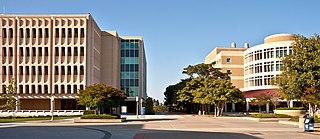
The School of Physical Sciences is an academic unit of the University of California, Irvine (UCI) that conducts academic research and teaching in the field of physical sciences. It offers both pre-professional training and general education in the departments of chemistry, earth system science, mathematics, and physics and astronomy. The school enrolls 1,400 undergraduate and graduate students and is one of the top schools in the nation in the number of degrees it confers in the area of physical sciences. It also offers specializations such as biochemistry, statistics, math for economics, applied and computational mathematics, astrophysics, applied physics, biomedical physics, and education. In 1995, the school gained international prominence when Frank Sherwood Rowland, a professor in chemistry and Frederick Reines, a professor in physics, won the Nobel Prize in their respective fields. It was the first time two people won the prize in the same year in two different fields at the same public university.
William Mitchinson Hicks, FRS was a British mathematician and physicist. He studied at St John's College, Cambridge, graduating in 1873, and became a fellow at the college.

Redvers House is an office block situated on Union Street in the centre of the city of Sheffield in South Yorkshire, England.

The University of Edinburgh School of Physics and Astronomy is the physics department of the University of Edinburgh. The School was formed in 1993 by a merger of the Department of Physics and the Department of Astronomy, both at the University of Edinburgh. The Department of Physics itself was a merger between the Department of Natural Philosophy and the Department of Mathematical Physics in the late 1960s. The School is part of the University's College of Science and Engineering.
The BYU College of Computational, Mathematical, and Physical Sciences was first organized in 1949 the College of Physical and Engineering Sciences. Engineering was later separated off and merged with the College of Industrial and Technical Education to form the College of Engineering and Technology. The founding dean of the newly formed College of Physical and Mathematical Science in 1972 was Jae R. Ballif. In 2024, as part of the 50th celebration of the college, it was rebranded to the name we know today: the College of Computational, Mathematical, and Physical Sciences. The name change celebrates the huge significance of not only the computer science department, but also how computing has changed each of the departments. The dean during this name change in 2024 was Grant Jensen.
The College of Science, Mathematics, and Technology was the science college of the former (1992-2015) University of Texas at Brownsville. It consisted of six academic departments. The six departments employed diverse faculty members - many of whom are leading experts in the fields - who have received funding from a variety of funding agencies, including the National Science Foundation, the National Institutes of Health, the Department of Education, and the Department of Defense, among others. The average active ongoing external funding is about 25-30 million dollars. In 2002, the Center for Gravitational Wave Astronomy (CGWA) research center was founded to help "develop excellence in research and education in areas related to gravitational wave astronomy."

The Mathematics Building in Manchester, England, was a university building which housed the Mathematics Department of the Victoria University of Manchester and briefly the newly amalgamated University of Manchester from 1968 to 2004. The building consisted of a three-storey podium and an 18-storey, 75 m (246 ft) tall tower. It was designed by local architect Scherrer and Hicks with a combination of 1960s-brutalism and international style modernism architecture. It was demolished in 2005 as the maths department moved to the Alan Turing Building on Upper Brook Street.
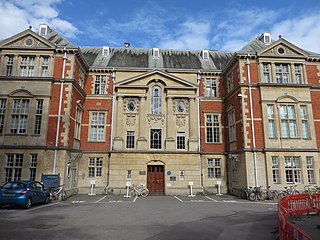
The Department of Physics at the University of Oxford is located on Parks Road in Oxford, England. The department consists of multiple buildings and sub-departments including the Clarendon Laboratory, Denys Wilkinson's building, Dobson Square and the Beecroft building. Each of these facilities contribute in studying different sub-types of physics such as Atomic and Laser Physics, Astrophysics, Theoretical Physics, etc. The physics division have made scientific contributions towards this branch of science since the establishment of the department.

The College of Science is a college within the University of Notre Dame. The Dean of the College of Science is Santiago Schnell, appointed Sept 1st, 2021.

The College of Science at the University of Utah is an academic college of the University of Utah in Salt Lake City, Utah. The college offers undergraduate and graduate degrees in atmospheric science, biology, chemistry, geology and geophysics, mathematics, metallurgical engineering, mining engineering and physics and astronomy.
The Graduate School of Princeton University is the main graduate school of Princeton University. Founded in 1869, the school is responsible for all of Princeton's master's and doctoral degree programs in the humanities, social sciences, natural sciences, and engineering. The school offers Master of Arts (MA), Master of Science (MS), and Doctor of Philosophy (PhD) degrees in 42 disciplines. It also administers several pre-professional programs, including the Master in Finance (M.Fin.), Master of Science in engineering (M.S.E.), and Master of Engineering (M.Eng.), Master in Public Affairs (M.P.A.), Master in Public Policy (M.P.P.), and Master of Architecture (M.Arch.) degrees.

The Macdonald-Harrington Building is a building located at 815 Sherbrooke Street West, on McGill University's downtown campus in Montreal, Quebec. Designed and built in Renaissance Revival style by Sir Andrew Taylor between 1896 and 1897, Macdonald-Harrington was one of the many donations made to the university by Sir William Macdonald. Today it houses the McGill School of Architecture and the School of Urban Planning, and prior to 1987, contained the Department of Metallurgy and Mining laboratories and the Department of Chemistry.

The Western Bank Campus is the main campus of the University of Sheffield. It lies one mile to the west of Sheffield city centre and is bounded by Upper Hanover Street to the east, Glossop Road to the south, Clarkson Street to the west, and Bolsover Street to the north. The campus includes Firth Court, Alfred Denny Building, Western Bank library and Arts Tower, Geography and Planning building, Bartolomé House, Dainton and Richard Roberts Buildings, the Sheffield Students' Union building, the Octagon Centre, Graves Building, Hicks Building and the Information Commons. The nearest motorway is the A57.















